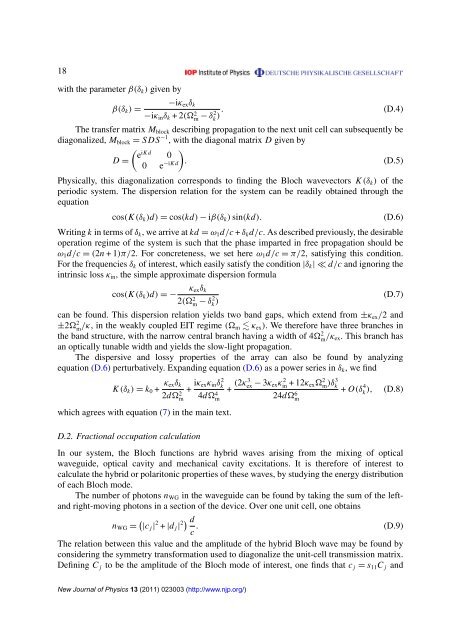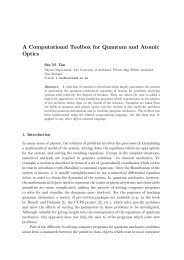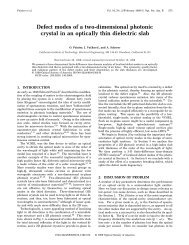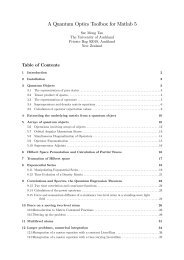Slowing and stopping light using an optomechanical crystal array
Slowing and stopping light using an optomechanical crystal array
Slowing and stopping light using an optomechanical crystal array
You also want an ePaper? Increase the reach of your titles
YUMPU automatically turns print PDFs into web optimized ePapers that Google loves.
18<br />
with the parameter β(δ k ) given by<br />
β(δ k ) =<br />
−iκ ex δ k<br />
−iκ in δ k + 2( 2 m − δ2 k ).<br />
(D.4)<br />
The tr<strong>an</strong>sfer matrix M block describing propagation to the next unit cell c<strong>an</strong> subsequently be<br />
diagonalized, M block = SDS −1 , with the diagonal matrix D given by<br />
( )<br />
e<br />
iK d<br />
0<br />
D =<br />
0 e −iK d . (D.5)<br />
Physically, this diagonalization corresponds to finding the Bloch wavevectors K (δ k ) of the<br />
periodic system. The dispersion relation for the system c<strong>an</strong> be readily obtained through the<br />
equation<br />
cos(K (δ k )d) = cos(kd) − iβ(δ k ) sin(kd).<br />
(D.6)<br />
Writing k in terms of δ k , we arrive at kd = ω 1 d/c + δ k d/c. As described previously, the desirable<br />
operation regime of the system is such that the phase imparted in free propagation should be<br />
ω 1 d/c = (2n + 1)π/2. For concreteness, we set here ω 1 d/c = π/2, satisfying this condition.<br />
For the frequencies δ k of interest, which easily satisfy the condition |δ k | ≪ d/c <strong><strong>an</strong>d</strong> ignoring the<br />
intrinsic loss κ in , the simple approximate dispersion formula<br />
κ exδ k<br />
cos(K (δ k )d) = −<br />
2( 2 m − δ2 k ) (D.7)<br />
c<strong>an</strong> be found. This dispersion relation yields two b<strong><strong>an</strong>d</strong> gaps, which extend from ±κ ex /2 <strong><strong>an</strong>d</strong><br />
±2 2 m /κ, in the weakly coupled EIT regime ( m κ ex ). We therefore have three br<strong>an</strong>ches in<br />
the b<strong><strong>an</strong>d</strong> structure, with the narrow central br<strong>an</strong>ch having a width of 4 2 m /κ ex. This br<strong>an</strong>ch has<br />
<strong>an</strong> optically tunable width <strong><strong>an</strong>d</strong> yields the slow-<strong>light</strong> propagation.<br />
The dispersive <strong><strong>an</strong>d</strong> lossy properties of the <strong>array</strong> c<strong>an</strong> also be found by <strong>an</strong>alyzing<br />
equation (D.6) perturbatively. Exp<strong><strong>an</strong>d</strong>ing equation (D.6) as a power series in δ k , we find<br />
K (δ k ) = k 0 + κ exδ k<br />
+ iκ exκ in δk<br />
2<br />
2d 2 m<br />
4d 4 m<br />
which agrees with equation (7) in the main text.<br />
+ (2κ3 ex − 3κ exκ 2 in + 12κ ex 2 m )δ3 k<br />
24d 6 m<br />
+ O(δ 4 k<br />
), (D.8)<br />
D.2. Fractional occupation calculation<br />
In our system, the Bloch functions are hybrid waves arising from the mixing of optical<br />
waveguide, optical cavity <strong><strong>an</strong>d</strong> mech<strong>an</strong>ical cavity excitations. It is therefore of interest to<br />
calculate the hybrid or polaritonic properties of these waves, by studying the energy distribution<br />
of each Bloch mode.<br />
The number of photons n WG in the waveguide c<strong>an</strong> be found by taking the sum of the left<strong><strong>an</strong>d</strong><br />
right-moving photons in a section of the device. Over one unit cell, one obtains<br />
n WG = ( |c j | 2 + |d j | 2) d<br />
c .<br />
(D.9)<br />
The relation between this value <strong><strong>an</strong>d</strong> the amplitude of the hybrid Bloch wave may be found by<br />
considering the symmetry tr<strong>an</strong>sformation used to diagonalize the unit-cell tr<strong>an</strong>smission matrix.<br />
Defining C j to be the amplitude of the Bloch mode of interest, one finds that c j = s 11 C j <strong><strong>an</strong>d</strong><br />
New Journal of Physics 13 (2011) 023003 (http://www.njp.org/)






